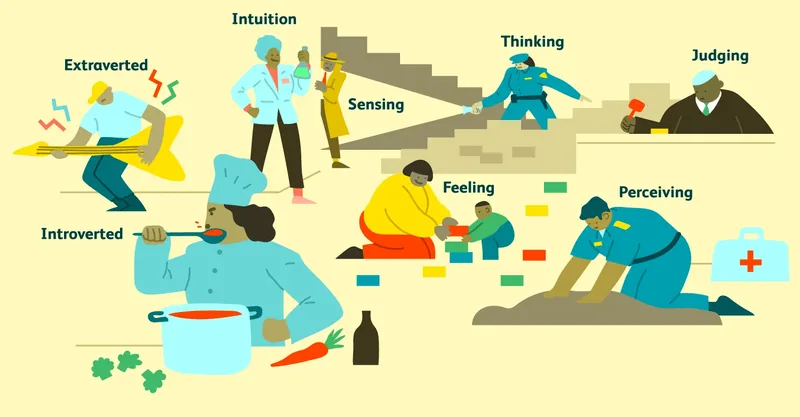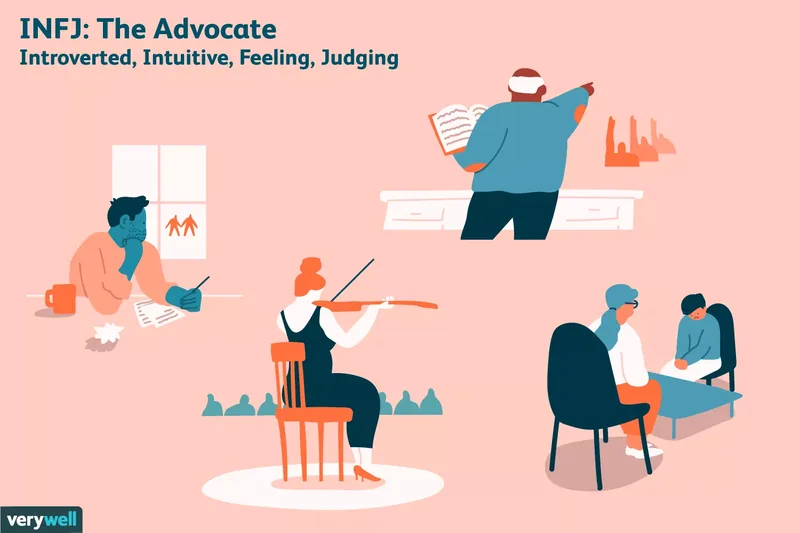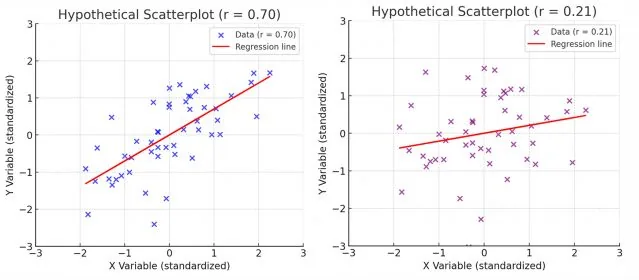Have you ever wondered what truly drives your decisions, how you interact with the world, or why certain careers resonate more than others? Understanding your personality can be a powerful tool for personal growth and professional success. The Myers-Briggs Type Indicator (MBTI) is a widely recognized self-report questionnaire designed to illuminate your inherent preferences, offering profound insights into your unique psychological makeup and how you engage with your environment. This comprehensive guide will explore the intricacies of the MBTI, helping you decipher your personality code and leverage it for a more fulfilling life in 2025.
Table of Contents
- Deciphering Your Inner World: How the Myers-Briggs Type Indicator Works
- The 16 Myers-Briggs Personality Types: A Comprehensive Overview
- Beyond the MBTI: Comparing Personality Assessments
- The Genesis of Self-Discovery: History of the Myers-Briggs Type Indicator
- Evaluating the Myers-Briggs Type Indicator: Reliability and Validity in Focus
- Harnessing Your MBTI Insights: Practical Applications and Modern Usage
Key Insights for Understanding Your Personality
- The Myers-Briggs Type Indicator utilizes self-report questions to pinpoint your natural preferences for interacting with the world.
- Your responses categorize you into one of 16 distinct personality types, based on four foundational preference pairs derived from Carl Jung's psychological theories.
- While the MBTI is immensely popular, its scientific reliability and validity remain subjects of ongoing academic discussion and research.
The Myers-Briggs Type Indicator is a self-report questionnaire that categorizes individuals into 16 distinct personality types, reflecting their innate preferences in thinking, decision-making, and social engagement. Developed by Isabel Myers and Katherine Briggs, building upon Carl Jung’s seminal work on psychological types, this framework helps you explore your inherent strengths and understand your relational dynamics. It has become one of the most popular personality frameworks globally, providing a valuable lens for self-awareness and interpersonal understanding.
1. Deciphering Your Inner World: How the Myers-Briggs Type Indicator Works
The Myers-Briggs Type Indicator operates on a simple yet profound premise: by answering a series of self-report questions, individuals can identify their natural preferences across four dichotomies, leading to their unique four-letter personality code. The primary goal of this personality assessment is to empower respondents to delve deeper into their own personalities, fostering a clearer understanding of their likes, dislikes, inherent strengths, and areas for potential growth. It also sheds light on possible career inclinations and compatibility dynamics with others, offering a roadmap for personal and professional development in 2025.
Crucially, the MBTI is not designed to label any personality type as "superior" or to diagnose dysfunction. Instead, it serves as a neutral tool for self-exploration, emphasizing that every type possesses inherent value and contributes distinct strengths. The questionnaire is structured around four fundamental scales, each representing a spectrum of preferences.
Extraversion (E) – Introversion (I)
This scale, originally conceptualized by Carl Jung, describes how individuals direct their energy and interact with the world. While many are familiar with these terms, the MBTI application provides a nuanced perspective beyond common usage.
- Extraverts (often spelled extroverts) are characterized as "outward-turning." They are typically action-oriented, thrive in social environments, and feel energized by engaging with groups and external stimuli. For example, an extravert might prefer brainstorming sessions with a large team to generate new ideas (Harvard, 2024).
- Introverts are "inward-turning" and tend to be thought-oriented. They value deep, meaningful interactions and often find their energy recharged after periods of solitude and reflection. An introvert might prefer to analyze a problem independently before sharing their conclusions with a small, trusted group.
While everyone exhibits both extraverted and introverted tendencies depending on the situation, the Myers-Briggs Type Indicator helps identify your dominant preference, indicating where you naturally feel more comfortable and energized.
Sensing (S) – Intuition (N)
This dichotomy explores how individuals gather and perceive information from their surroundings. Just like extraversion and introversion, people utilize both sensing and intuition, but one preference typically dominates.
- People who prefer sensing are grounded in reality, focusing intently on concrete facts and what can be directly observed through their five senses. They appreciate practical details and often learn best through hands-on experience. A sensing type might meticulously follow a recipe step-by-step, ensuring every measurement is exact.
- Those who prefer intuition are more attuned to patterns, impressions, and underlying meanings. They enjoy exploring possibilities, envisioning future scenarios, and engaging with abstract theories. An intuitive type might enjoy experimenting with new ingredients and techniques, focusing on the overall flavor profile rather than strict adherence to a recipe.
Understanding this preference can significantly impact how individuals approach problem-solving, learning, and planning.
Thinking (T) – Feeling (F)
This scale illuminates how individuals make decisions based on the information they have gathered. It highlights the primary drivers behind their judgments.
- People who prefer thinking prioritize facts, objective data, and logical analysis. They tend to be consistent, impersonal, and rational in their decision-making processes. For instance, a thinking type might choose a car based solely on its fuel efficiency, safety ratings, and price, rather than its aesthetic appeal or emotional connection.
- Those who prefer feeling place a greater emphasis on human values, emotions, and the impact of decisions on people. They strive for harmony and often consider the subjective experiences of others when reaching conclusions. A feeling type might choose a car that evokes a sense of joy or comfort, or one that aligns with their personal values, even if it's not the most "logical" choice.
Both approaches are valid and essential for well-rounded decision-making.
Judging (J) – Perceiving (P)
The final scale describes an individual's preferred approach to the external world and how they organize their life.
- Those who lean toward judging prefer structure, order, and definitive decisions. They like things settled and planned, often preferring to complete tasks well in advance. A judging type might meticulously plan their entire week, scheduling every appointment and task.
- People who lean toward perceiving are more open, flexible, and adaptable. They prefer to keep their options open, enjoying spontaneity and adjusting plans as new information arises. A perceiving type might have a general idea of their week but remain open to last-minute invitations or changes in priorities.
These two tendencies interact with the other scales, influencing whether an individual's extraverted behavior is focused on taking in new information (Sensing and Intuition) or on making decisions (Thinking and Feeling). The Myers-Briggs Type Indicator helps clarify these nuances, providing a holistic view of personality.
2. The 16 Myers-Briggs Personality Types: A Comprehensive Overview
The combination of your preferences across the four dichotomies results in one of 16 distinct personality types, each represented by a unique four-letter code. Each type offers a specific lens through which individuals perceive and interact with the world, highlighting their inherent strengths and characteristic approaches. Recognizing your type, or the type of others, can foster greater understanding and improve communication, especially in diverse teams in 2025.
Here's a breakdown of the 16 Myers-Briggs Type Indicator personality types:
The Analysts (Intuitive-Thinking)
These types are characterized by their logical approach and focus on possibilities.
- INTJ - The Architect: Reserved, highly logical, and strategic thinkers, they are known for their visionary insights and ability to plan complex systems. They often excel in fields requiring deep analysis and innovation.
- INTP - The Thinker: Quiet, analytical, and imaginative, INTPs possess a rich inner world of ideas and theories. They are driven by curiosity and a desire to understand the fundamental principles of how things work.
- ENTJ - The Commander: Outspoken, confident, and natural leaders, ENTJs are highly organized and excel at setting ambitious goals and mobilizing others to achieve them. They thrive in positions of leadership and strategic planning.
- ENTP - The Debater: Inventive, enthusiastic, and often challenging, ENTPs love intellectual sparring and exploring new ideas. They are excellent problem-solvers who enjoy innovation, though they may struggle with completing projects once the initial excitement fades.
The Diplomats (Intuitive-Feeling)
These types are guided by their intuition and values, often focusing on human connection and meaning.
- INFJ - The Advocate: Creative, insightful, and deeply empathetic, INFJs are considered one of the rarest personality types. They are driven by a strong sense of purpose and a desire to help others realize their potential.
- INFP - The Mediator: Idealistic, compassionate, and highly valuing authenticity, INFPs strive to make the world a better place by aligning their actions with their deeply held principles. They are often drawn to creative and humanitarian pursuits.
- ENFJ - The Giver: Warm, charismatic, and highly attuned to the emotions of others, ENFJs are natural facilitators and motivators. They are known for their generosity and ability to inspire communities towards common goals.
- ENFP - The Champion: Enthusiastic, creative, and highly sociable, ENFPs are energized by new possibilities and connecting with people. They bring a vibrant energy to any situation and are driven by a desire to explore life's rich tapestry of experiences.
The Sentinels (Sensing-Judging)
These types are practical, grounded in reality, and appreciate structure and order.
- ISTJ - The Inspector: Reserved, practical, and highly responsible, ISTJs are known for their loyalty, meticulousness, and adherence to tradition. They are the backbone of many organizations, ensuring tasks are completed accurately.
- ISFJ - The Protector: Warm-hearted, dedicated, and highly dependable, ISFJs are always ready to support and protect the people they care about. They are often the quiet caregivers who ensure everyone's needs are met.
- ESTJ - The Director: Assertive, principled, and highly organized, ESTJs are natural leaders who excel at establishing clear rules and guiding groups towards efficient outcomes. They are decisive and value competence.
- ESFJ - The Caregiver: Sociable, warm, and highly considerate, ESFJs are deeply invested in the well-being of their communities. They are excellent at fostering harmony and ensuring social needs are met, often believing the best in others.
The Explorers (Sensing-Perceiving)
These types are adaptable, spontaneous, and enjoy engaging with the present moment.
- ISTP - The Crafter: Independent, practical, and highly adaptable, ISTPs thrive on hands-on experiences and mastering practical skills. They enjoy understanding how things work and are often resourceful problem-solvers.
- ISFP - The Artist: Easy-going, sensitive, and deeply artistic, ISFPs live in the moment and express themselves through creative endeavors. They value personal freedom and authentic experiences.
- ESTP - The Persuader: Outgoing, energetic, and spontaneous, ESTPs enjoy being at the center of the action and thrive on new experiences. They are pragmatic problem-solvers who focus on immediate results.
- ESFP - The Performer: Charismatic, spontaneous, and outgoing, ESFPs love to entertain and enjoy taking center stage. They bring joy and enthusiasm to social gatherings and are highly responsive to their environment.
Taking the Myers-Briggs Type Indicator can offer profound self-insight, which is a major reason for its enduring popularity. Even without a formal assessment, you might recognize some of these tendencies within yourself or others. The Myers & Briggs Foundation consistently emphasizes that every personality type holds unique value and contributes distinct strengths, reinforcing the idea that diversity in personality is a powerful asset in any context. For instance, in a project team, recognizing that an INTJ excels at strategic planning while an ESFP is brilliant at motivating and presenting can optimize task assignment and collaboration, leading to more effective outcomes.
3. Beyond the MBTI: Comparing Personality Assessments
The Myers-Briggs Type Indicator is a prominent method for personality typing, which broadly refers to systems that categorize individuals based on their inherent traits, behavioral tendencies, and other psychological characteristics. While the MBTI is widely used, it's important to understand how it contrasts with other popular personality frameworks available in 2025. These alternative assessments offer different lenses through which to view human personality, each with its own methodology and focus.
Other well-known personality tests include:
- The Enneagram: This system describes nine interconnected personality types, each with its own core motivations, fears, and desires. It focuses heavily on understanding inner drives and paths for growth.
- The Five Love Languages: While not a traditional personality test, it categorizes how individuals prefer to give and receive love (Words of Affirmation, Quality Time, Receiving Gifts, Acts of Service, Physical Touch), impacting relational dynamics.
- The Big Five Personality Assessment (OCEAN): This academic model measures personality across five broad dimensions: Openness to Experience, Conscientiousness, Extraversion, Agreeableness, and Neuroticism. It is often considered the most scientifically robust model in psychology.
- The Workplace DISC Test: Focusing on observable behavior, DISC categorizes individuals into four main styles: Dominance, Influence, Steadiness, and Conscientiousness. It is particularly popular for improving workplace communication and team dynamics.
- Cattell's 16 Personality Factor Questionnaire (16PF): Developed by Raymond Cattell, this assessment measures 16 primary personality traits, providing a more granular profile than the Big Five.
The Myers-Briggs Type Indicator, however, distinguishes itself in several key ways. Firstly, it is not accurately described as a "test" in the conventional sense. There are no right or wrong answers, and consequently, no "better" or "worse" type. Its purpose is not to evaluate mental health, identify psychological abnormalities, or offer clinical diagnoses. Instead, the MBTI aims to provide a framework for self-understanding and appreciation of individual differences.
Secondly, unlike many other psychological evaluations that compare an individual's score against a normative population, the MBTI's results are not benchmarked against others. The instrument's sole objective is to offer detailed, personalized information about your unique preferences and personality composition. This focus on individual insight, rather than comparison or pathology, makes the Myers-Briggs Type Indicator a distinct tool in the landscape of personality assessments, emphasizing personal growth and self-acceptance over competitive ranking. For instance, while the Big Five might tell you how "extraverted" you are compared to the average person, the MBTI will tell you that you prefer extraversion, and what that preference implies for your energy and interaction style.
4. The Genesis of Self-Discovery: History of the Myers-Briggs Type Indicator
The story of the Myers-Briggs Type Indicator is one of intellectual curiosity and a deep desire to apply complex psychological theories to everyday life. Its origins trace back to the mid-20th century, driven by the insights and dedication of Isabel Myers and her mother, Katherine Briggs. Both women were profoundly captivated by the work of Swiss psychiatrist Carl Jung, particularly his groundbreaking theory of psychological types, which posited that people experience the world using four principal psychological functions: sensation, intuition, feeling, and thinking, with one being dominant for a person.
Myers and Briggs recognized the immense real-world potential of Jung's abstract concepts. They envisioned a practical tool that could help individuals understand their inherent differences and, crucially, leverage this understanding to lead more fulfilling lives. This vision became particularly poignant during World War II, a time when many women were entering the workforce in unprecedented numbers, often in roles unfamiliar to them. Myers and Briggs began their meticulous research and development of an indicator to assist people in identifying their natural preferences.
Their core belief was that by providing individuals with a clearer understanding of their own personalities, they could guide them toward occupations that were not only best suited to their psychological types but also conducive to greater personal satisfaction and overall well-being. This early focus on career guidance and personal alignment remains a key application of the Myers-Briggs Type Indicator today.
Isabel Myers developed the initial pen-and-pencil version of the inventory during the 1940s. The two women then embarked on an extensive testing phase, refining the assessment through careful observation and feedback from friends and family. This iterative process of development and validation continued for over two decades, demonstrating their commitment to creating a robust and insightful instrument. Their tireless efforts ultimately led to the formal publication of the Myers-Briggs Type Indicator, which has since grown into a globally recognized framework for self-understanding. The enduring legacy of their original research continues to influence how individuals and organizations approach personality assessment and development in 2025.
5. Evaluating the Myers-Briggs Type Indicator: Reliability and Validity in Focus
The scientific credibility of the Myers-Briggs Type Indicator has been a subject of extensive debate within the psychological community. On one hand, proponents, including The Myers & Briggs Foundation, assert that the MBTI meets accepted standards for both reliability and validity. They often cite internal studies suggesting a high level of accuracy and test-retest reliability, sometimes claiming as high as 90%. This implies that an individual should typically receive the same results if they retake the assessment after a reasonable period, and that the instrument effectively measures what it purports to measure (Harvard, 2024). An older meta-analytic study, for example, observed strong internal consistency and test-retest reliability across various research, lending some support to these claims.
However, a significant body of academic research and critical analysis raises serious questions about the instrument's overall scientific validity. Many studies indicate that the MBTI's reliability, particularly its test-retest reliability, has not been adequately demonstrated. Critics point to research suggesting that a considerable percentage of individuals receive different results when they retake the test, sometimes even shifting between opposing preferences (e.g., from an 'E' to an 'I') within a relatively short timeframe. This inconsistency undermines the idea that the MBTI measures stable, enduring personality traits.
Furthermore, the predictive validity of the Myers-Briggs Type Indicator has also come under scrutiny. Some research suggests that the MBTI is not a strong predictor of success in specific careers or job performance, challenging its widespread use in occupational guidance and team building. Psychologists often argue that the dichotomous nature of the MBTI (e.g., you are either an Extravert or an Introvert, with no middle ground) oversimplifies the complexity of human personality, which is more accurately represented by continuous scales rather than binary choices. The forced-choice format, where respondents must choose between two options even if they feel both or neither apply, can also contribute to inconsistent results.
While the Myers-Briggs Type Indicator remains incredibly popular and widely utilized in corporate training, personal development, and educational settings, the lack of consistent, robust evidence for its scientific validity leads many academic psychologists to caution against its use as a definitive tool for personality assessment or career counseling. For users in 2025, it's crucial to approach MBTI results with an understanding of these ongoing scientific debates, appreciating its value as a framework for self-reflection rather than a definitive scientific diagnosis.
6. Harnessing Your MBTI Insights: Practical Applications and Modern Usage
The enduring appeal of the Myers-Briggs Type Indicator lies in its accessibility and the profound insights it can offer into personal preferences and interpersonal dynamics. Its relatively straightforward framework makes it one of the most popular psychological instruments globally, with approximately two million adults in the U.S. alone completing some version of the inventory each year. In 2025, its applications continue to evolve, extending beyond individual self-discovery to enhancing team collaboration and organizational effectiveness.
While countless informal versions of the Myers-Briggs Type Indicator are available online, it is crucial to understand that these are merely approximations of the genuine assessment. For the most accurate and insightful results, the formal MBTI questionnaire must be administered by a trained and qualified practitioner. This process typically includes a comprehensive follow-up session where your results are professionally interpreted, allowing for a deeper understanding of your preferences and their implications. Today, the official questionnaire can be completed online through its publisher, CPP, Inc., ensuring that respondents receive a certified interpretation of their personality type.
The current North American version of the Myers-Briggs Type Indicator typically consists of 93 forced-choice questions, while the European version includes 88. For each question, respondents are presented with two distinct options and must choose the one that best reflects their natural preference. This format aims to identify innate tendencies rather than learned behaviors.
Leveraging your MBTI insights in 2025 can unlock several practical benefits:
- Personal Growth: Understanding your type can help you identify your natural strengths and areas where you might need to develop. For instance, an INFP might learn to better articulate their deeply held values, while an ESTJ might focus on developing more empathy in leadership.
- Career Exploration: While not a definitive predictor of success, the Myers-Briggs Type Indicator can highlight career paths that align with your natural preferences, potentially leading to greater job satisfaction. For example, an INTJ might thrive in strategic planning or research, whereas an ESFP might excel in dynamic, people-focused roles like event management or sales.
- Improving Communication: Knowing your type and understanding the types of others can significantly enhance communication. Recognizing that a "Thinker" prioritizes logic while a "Feeler" prioritizes harmony can help tailor your approach to ensure your message is received effectively.
- Team Dynamics: In group settings, the MBTI can be a powerful tool for building stronger, more cohesive teams. By understanding the diverse strengths that each personality type brings, team leaders can assign tasks more effectively, foster mutual respect, and mitigate potential conflicts. For example, a team might consciously ensure they have both "Judgers" to drive decisions and "Perceivers" to keep options open during the initial brainstorming phase.
- Conflict Resolution: Insights from the Myers-Briggs Type Indicator can provide a neutral framework for discussing differences in approach, helping individuals understand that varying perspectives often stem from fundamental personality preferences rather than personal antagonism.
By embracing the insights provided by the Myers-Briggs Type Indicator, individuals can embark on a journey of deeper self-awareness, improve their relationships, and make more informed decisions about their life and career paths in an increasingly complex world.




